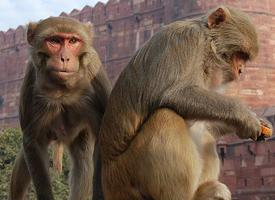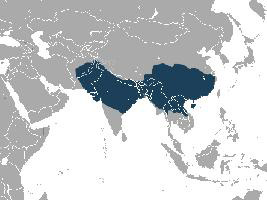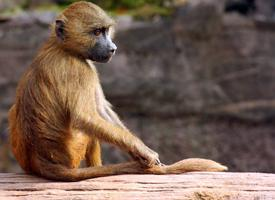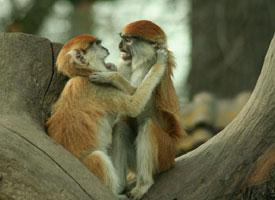
Poids et mesures
| Longueur | de 50 à 60 cm |
|---|---|
| Poids | de 7,5 à 8,2 kg |
| Longueur de la queue | 25 cm |
Données biologiques
| Durée de vie | de 20 à 30 ans |
|---|---|
| Nombre de petits | 1 |
Statut de conservation
| Menacé |
Description de l'animal
The Rhesus macaque (Macaca mulatta) is a species of Old World monkey that holds significant interest for various fields, including biological research, conservation, and understanding human evolution. This medium-sized primate is native to South, Central, and Southeast Asia, showcasing a remarkable adaptability that allows it to thrive in diverse environments, ranging from grasslands to arid and forested areas, including mountainous regions.Characterized by its dusty brown or grey coat and a pink, hairless face, the Rhesus macaque has a distinctive appearance. Adults usually weigh between 5 to 15 kilograms, with males generally being larger and heavier than females. One of their most notable physical features is the rump's bright red color, especially pronounced in females. Their tails are of medium length, adding to their balanced physique, which is well-adapted for both arboreal and terrestrial living.
Rhesus macaques are highly social animals, forming complex hierarchical groups typically ranging from 20 to over 200 individuals. These groups are matriarchal, with females remaining in their natal groups for life and males leaving the group upon reaching adolescence. Social hierarchies are strictly maintained through a combination of grooming, vocalizations, and sometimes aggression.
Their diet is omnivorous, consisting of fruits, seeds, roots, and small animals, including insects. This varied diet, combined with their ability to adapt to various environments, has been a key factor in their widespread distribution.
Rhesus macaques have a significant overlap with human habitats, leading to various interactions, both positive and negative. In some areas, they are considered pests, raiding crops and entering urban areas in search of food. However, their close genetic relationship to humans has also made them invaluable in medical and scientific research. They have been crucial in numerous studies, including vaccine development, understanding human diseases, and even space missions.
Their reproductive cycle is characterized by a gestation period of about 164 days, after which usually a single offspring is born. The young are cared for intensively by their mothers and other females in the group, playing a crucial role in the social learning and development of the juveniles.
Conservation status of the Rhesus macaque varies by region, but they are not currently considered endangered. However, habitat destruction, hunting for food and trade, and conflict with humans pose ongoing threats to certain populations. Despite these challenges, their adaptability and wide distribution have allowed them to maintain relatively stable populations in the wild.
In conclusion, the Rhesus macaque (Macaca mulatta) is a fascinating and resilient species, playing crucial roles in ecosystems, scientific research, and highlighting the complex interactions between wildlife and humans. Their continued study offers valuable insights into primatology, conservation, and our own place within the natural world.
Carte de répartition

Animaux similaires
Nouvelles photos d'animaux
Top 10 des animaux
- Dolphin gull (Leucophaeus scoresbii)
- Diana monkey (Cercopithecus diana)
- Moustached guenon (Cercopithecus cephus)
- Galápagos tortoise (Geochelone nigra complex)
- Stone loach (Barbatula barbatula)
- Japanese macaque (Macaca fuscata)
- Russian tortoise (Testudo horsfieldii)
- Common flying dragon (Draco volans)
- Greek tortoise (Testudo graeca)
- Vendace (Coregonus albula)


